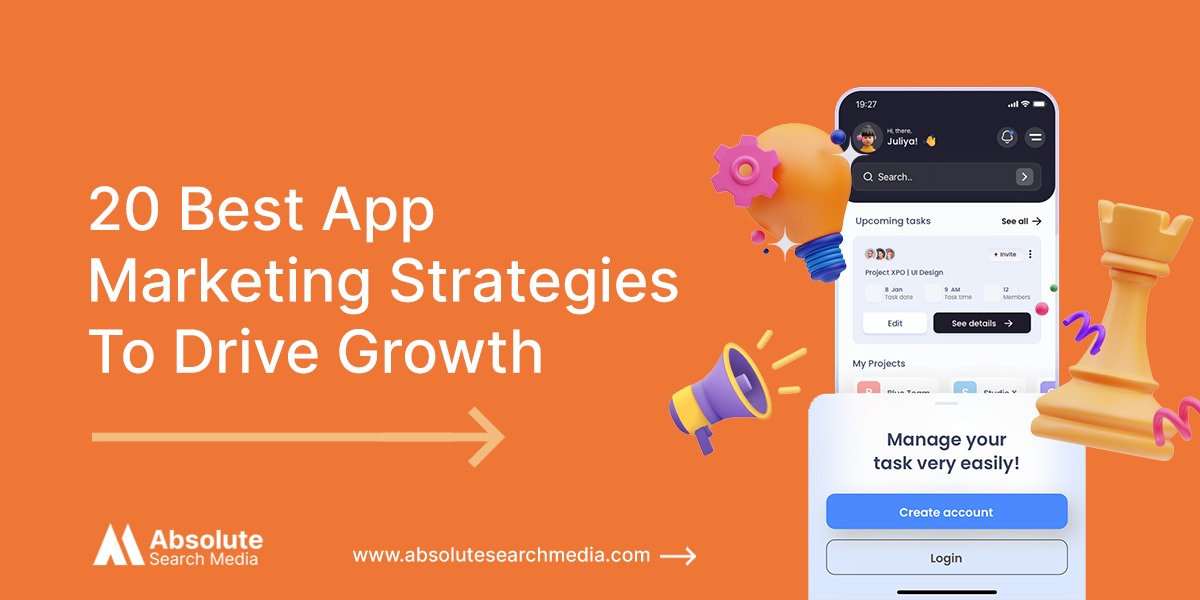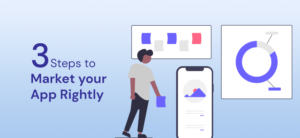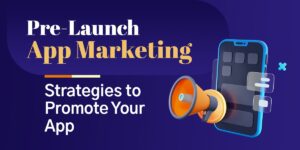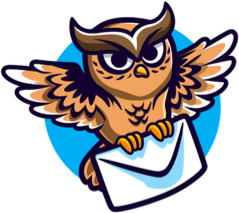How to Market an App: The Complete App Marketing Strategies
Published On
February 17, 2022
With 6.3 billion smartphone users worldwide, the mobile application development industry is consistently thriving. While Apple App Store has 1.96 million applications for download, the number of apps available for download on the Google Play Store is 2.87 million. But do you know that 25% of apps downloaded by the users are used only once? Besides, there are loads of apps that never get downloaded. The reason behind this is the ignorance of app marketing.
Many companies launch brilliant apps without making a marketing strategy and end up losing potential users. On the other hand, there are apps that are unable to experience frequent downloads due to poor or lack of marketing. If you don’t want to make the same mistake, then start planning your app marketing strategies right away.
But how to come up with a strategy that makes your app stand out? What’s the correct way to boost app downloads? Which process to follow to bring more engagement and traffic? Not to worry, we bring you this interesting blog that will answer these questions, clear many other doubts, and help you market your app the right way.

Before we look at the powerful app marketing strategies to promote mobile applications, let’s consider this step-by-step process that can accelerate your sales and marketing funnel and take your business to the next level.
You need to be clear about your key objectives and end goals. Make a list of the desired outcomes that you want to achieve by marking your app. Identify your target audience and what they expect from you. Your app’s purpose should be directly connected to your users and prove beneficial in the long run.
Instead of adding too many features to your app, you need to focus on awareness. Make sure the users know what your app stands for and represents as a whole. Make them understand the problems you address and the solutions you offer. Altogether, the purpose should be to push your users to download your app and use it regularly.
You can choose either Android or iOS, depending on your mobile app development platform. Android will help you meet distinctive features like voice assistants, cloud services, open-source benefits, wide-ranging reach, map integration, customization, ease of approval, etc. With iOS, you can get an array of benefits, including updates, usability, development speed, higher earnings, and so on.
Keeping all this in mind, you need to finalize the distribution channels. The selection completely depends on how you want to market your app, followed by the budget in place. Some popular app marketing channels that you can count on include App Stores (Google Play and Apple App), Pay-Per-Install Networks, Online Ads, App Cross-Promotion Networks, Facebook Targeted Ads, App Recommendation Programs, Promoted Tweets, App Directory Listing, etc.
After defining your app’s purpose and potential distribution channels, the next big step is to monetize your app. You already know that marketing your app requires a certain amount of investment, and at the very least, you have to create ways to get that money back, generate good ROI, or make profits. In simple words, the app revenue model refers to the sources and ways through which your mobile app can make money.
There are many app revenue models available across the market to choose from. The major ones include In-app Advertising, In-App Purchases, Subscriptions, Data Monetization, Donations, Affiliate Marketing and Lead Generation, SMS and Email Marketing, Sponsorships, and Paid Apps.
Not that you know all the basics of app marketing and how to do it in an effective manner, let’s move forward to understanding some key app marketing strategies. We have categorized these strategies in 3 stages as follows:

1. Create an Irresistible App Icon:
It is necessary for you to design a simple yet effective app icon for your app. This icon should create a lasting impact on your target audience. It should perfectly reflect your app’s purpose and vision. Subtle colors, sizes, and shapes can be your best bet. You can also go through your competitor’s app icons to find out the key differentiator.
2. Choose Your App’s Category Wisely:
The Apple App Store’s App categories include AR Apps, Education, Entertainment, Finance, etc., and Games categories include Action, Adventure, AR Games, Board, and so on. The Google Play Store’s App categories include Art & Design, Auto & Vehicles, Beauty, Business, etc., and Games categories include Arcade, Card, Casino, Casual, and so on. You need to choose a category that your app falls in.
3. Pay Attention to Above the Fold:
You need to position your first impression frame in such a manner that users cannot resist downloading it. Focus on the upper half of the page for both – Google Play and the Apple App Store. App title, price, icon, gallery, description, and ratings are some of the areas you need to concentrate on to get app downloads frequently.
4. Conduct Market Research to Understand Your Customer:
Persona research should be an important part of your app marketing strategies. Make sure you perform thorough research to identify who your target customers are and what they seek. The key areas you need to consider while researching include name, location, education, medium of purchase, interests, life goals, pain points, earnings, social media presence, mobile devices used, and more.
5. Design and Share Interesting Infographics:
Independent research states that humans have a shorter attention span. That’s why you need to design and promote your app through infographics. Also, information in the form of visuals is bound to get acknowledged quickly. For example, you can discover popular topics and events concerning your app features and develop compelling data structures around them.
6. Create A Content Marketing Strategy:
The right content marketing strategy can create brand awareness, pull in the needed traffic, generate leads, and convert them into potential customers. It can help your app rank on the first page of the top search engines. For instance, you can start writing blogs and articles around your app, focusing on the industry as a whole.
7. Create A Website or Landing Page:
Creating a website or a pre-launch landing page can prove beneficial. This will help you spread awareness and create hype. You can also attract your target users by aligning your landing page with proven SEO strategies.
8. Outreach Initiatives:
Promote your landing page by partnering with potential influencers, publications, and bloggers to get real reviews and backlinks. Connect with the individuals or third-party agencies that are relevant to your app’s niche and are eager to promote your app on their website. You can also take the help of your professional circle.
9. Develop an Accompanying App Video:
Create an eye-pleasing app teaser or a 30-second video that conveys what will your app exactly bring to the table. Try highlighting your app’s USP, features, functionalities, value propositions, future goals, etc., in the video in a clear, crisp, and concise manner. Needless to say, promote it on YouTube and other video content sharing platforms.
10. Promote on social media:
Promoting on social media is a must. Social Media Strategy includes posting banners, PRs, blogs/ articles, whitepapers, and case studies on different social media platforms, especially Twitter, Facebook, and Instagram. Do not underestimate the popularity of Q& platforms like Quora. You can also identify the right communities on Reddit or boost your app awareness with SlideShare.
11. Set a Launch Date and When You Launch, Make It Big:
Apple has a strict review process in comparison to Google which may cause delays while releasing. Keeping this in mind, you need to set a launch date for your app and be ready for any type of hard contingencies. Make sure to make your launch worthy enough to get more traction. Publish newsletters, social media campaigns, PRs, etc., and let your users know that something big is on its way.
12. Create a Facebook Group:
Your app marketing strategies should definitely involve the creation of a Facebook group. It is easy to create and can help you engage with your users in a better manner. You also get the opportunity to post relevant content in the group, ask for suggestions and feedback, observe different perspectives, and grow your user base.
13. Offer Your App in Other Languages: Ensure that you offer your app in multiple languages and adopt localization to your benefit. This will improve the visibility in search results and expand your user base alongside increasing app downloads. For example, if you localize your product in 4 different countries, then you will pragmatically have 4X keyword combinations.
14. Reach Out to Journalists to Get Needed Press:
You should reach out to journalists and news reports/ editors to get the limelight. Try to build important relationships with print as well as digital news magazines and get featured for creating an app that solves a particular problem. You can also approach sites like Lifehack.com, TechCrunch, Mashable, Gizmodo, etc., to get full coverage.

15. Paid Strategy (Take Advantage of Mobile Advertising)
The concept of paid advertising can do wonders for your app and present it to a large audience. For this, you can use social media sites like YouTube, Instagram, and Facebook or run PPC ad campaigns via Google AdWords. Apart from all this, cross-promotions, mobile banners, interstitial ads, and native ads are some of the paid ad formats that you can opt for.
16. Do App Store Optimization
ASO or App Store Optimization is the backbone of your app marketing strategy. Begin by adding a short but impactful description. Focus on keyword optimization and maximization as per the set character limit for Google Play, Apple App, or any other enterprise app store. Include self-explanatory, engaging screenshots, images, and videos.
17. Pitch to the Editorial Team to Be Featured in the App Store
Another important marketing strategy to watch out for during the acquisition stage is getting featured in the App Store. Every day, free/ paid apps or games are reviewed by the curators of the App Store. Apple receives various pitches to feature applications. This strategy can prove beneficial if performed with conviction. You need to make a pitch that showcases your app’s uniqueness and value.
18. Hire Mobile App Marketing Agencies
When you hire a mobile app marketing agency, you don’t need to worry about how to increase app downloads. These agencies can help you expand your user base with their experience, expertise, and networks. They have good knowledge about the tools and technologies that can promote your mobile app on a larger scale.
19. Apply for App Awards:
When your app gets awards, it creates a sense of credibility and awareness among your users. And awareness is the key to app promotion. As such, you can easily build trust among your target audience by applying for app awards like Appy, Best App Ever, Apple Design, Appsters, The Webby, Best Mobile App, and so on.
Resolve Negative Reviews Promptly: Develop the habit of paying attention to user feedback and suggestions. Monitor the issues they are facing on regular basis and resolve negative reviews with utmost immediacy. Let the users know that the issues are being taken care of. Try to convert negativity into positivity by solving one issue at a time.
20. Get a Steady Stream of Review:
One of the most important app marketing strategies that can help you boost your app downloads online reviews. Users tend to trust online recommendations and reviews. So, you need to connect with online reviewing sites to talk about your app. Align with potential individuals who make product-reviewing videos, blogs, and articles to pull in more traffic.
21. Send your Video with your Review Requests to the Bloggers:
One thing to keep in mind while approaching a steady stream of reviews from famous bloggers is to send your app’s videos. This will help them in understanding your app in a better manner and posting the content accordingly. It will also make the review easier and ultimately lead to better app promotion.
22. Use QR Codes for Promotion
QR or Quick Response code is a powerful app marketing technology to look out for. Users can scan this code from their smartphones and get redirected to your website or landing page. You can link it to your app and redirect your users to the needed app store depending on the device and operating system.
23. Consider Alternative App Stores
Getting the needed popularity across two giant app stores – Google Play and Apple App can sometimes get tricky. In such situations, you can explore less competitive app publishing alternatives such as APKPure, 9Apps, Amazon Appstore, Aptoide, F-droid, Aurora Store, Samsung Galaxy Store, GetApps, and so on.
24. Take Advantage of SEO For Your App Review Pages
You need to strictly follow key SEO guidelines for your app review pages. Do not focus on stuffing keywords, Instead, you should optimize primary keywords and increase the usage of long-tail keywords. Doing this will boost your organic ranking, offer value, and come up as a viable app store search result.
25. Reach Out to Your Mobile App Influencers via Email
Make the best use of email marketing. Optimize and segment your emails for your mobile app influencers to increase the chances of generating a higher ROI. For instance, you can consider a particular mailout to connect with your influencers – organize a challenge, distribute gifts, list discounts, re-engagement, public speaking, etc.

26. Establish Two-Way Communication
You need to think like customers who want to increase app downloads if you actually want to increase app retention. Moreover, you need to focus on a two-way communication strategy where user feedback is addressed with utmost priority. Establish long-standing relationships with your users, where they provide suggestions and you are ready to incorporate them (if relevant).
27. Consider Offering a Promotional Price
When it comes to app marketing, offering promotional prices can definitely help you get app installs on the go. Promotional offers have the power to entice your audience and influence them to make a purchase. Additionally, getting things at a discounted price or for free can obligate users to your brand identity.
28. Push Notifications Strategy
Push notifications are bigger than you think and can help you successfully promote your app after it is live. Just make sure to not overboard with your users with recurring messages or consistent beeps. Limit your notifications to twice a week. However, if your app is getting highly noticed, then notifying users with creative messages once or twice a day is fine.
29. Ask Users for Feedback and Fix App Issues Fast
You need to look for potential app errors, downtimes, bugs, or any other lagging issues and fix them as quickly as possible. Ask for user feedback, understand their point of view, and make alterations to your app accordingly. Make sure you keep up with the times and current market trends in order to execute relevant app updates.
30. Consider A Burst Campaign
A burst campaign is nothing but a popular app promotion strategy used by marketing professionals to rank in the app store. What it exactly means is a sudden outbreak for your app in which you get aligned with a paid media exposure for a short time span. This time can be between 24-72 hours or more depending on your set budget plan.
31. Offer A Referral Bonus
Another important technique to promote your app after the launch is referral marketing. It is a technique where users are offered a pre-defined or surprise bonus if they promote your app online. It is a digital word of mouth supported by referral programs like cash, shopping vouchers, discount coupons, and much more.
32. Run a Contest
Nobody would believe that app marketing can be done by running a contest. But it is possible. Depending on your audience and app type, you can come up with a sponsored contest. For example, you can give internships or scholarships to individuals who design the best alternative logo for your app and promote it on social media by tagging you.
33. Increase loyalty
Prioritizing analytics and working on the generated insights can help you improve your app loyalty standards. Concretely, you need to work on data-driven personalization. Along with this, you can take advantage of geo-enabled messaging or use a combination of app channels. Digital loyalty cards and enhancing the user experience with gamification are also good-to-go options.
When how to increase app installs is the question, Absolute Search Media is the answer. ASM is a full-service digital marketing company that empowers your business to thrive and grow. Our proven app marketing strategies powered by a dynamic team of creative marketing professionals help you scale your app head-on. Be it ad creation, campaign optimization, conversion rates tracking, remarketing, etc., our digital marketing services will help you reach potential customers and boost ROI by all means.
So, what are you waiting for? Start your app marketing journey with ASM right away!

Get In Touch With Our Team And Experience A Smarter Approach To Digital Marketing.